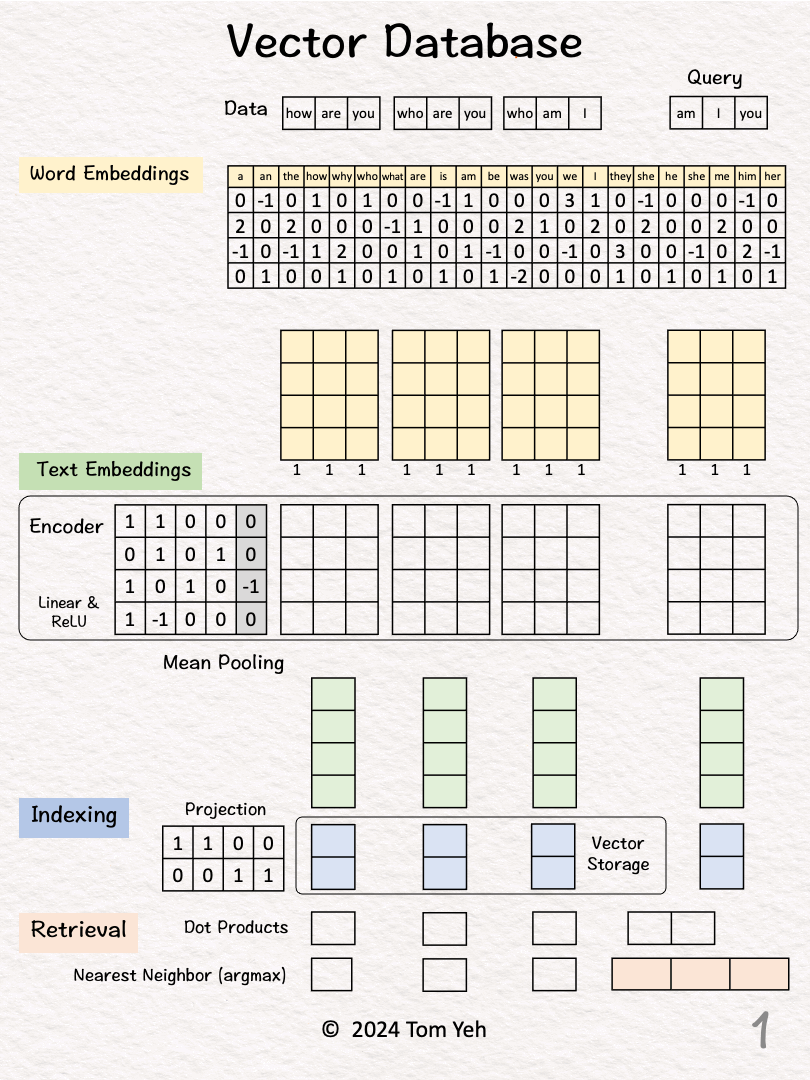Vector Database by Hand ✍️
Vector databases are revolutionizing how we search and analyze complex data. They have become the backbone of Retrieval Augmented Generation (RAG).
How do vector databases work?
[1] Given
↳ A dataset of three sentences, each has 3 words (or tokens)
↳ In practice, a dataset may contain millions or billions of sentences. The max number of tokens may be tens of thousands (e.g., 32,768 mistral-7b).
Process "how are you"
[2] 🟨 Word Embeddings
↳ For each word, look up corresponding word embedding vector from a table of 22 vectors, where 22 is the vocabulary size.
↳ In practice, the vocabulary size can be tens of thousands. The word embedding dimensions are in the thousands (e.g., 1024, 4096)
[3] 🟩 Encoding
↳ Feed the sequence of word embeddings to an encoder to obtain a sequence of feature vectors, one per word.
↳ Here, the encoder is a simple one layer perceptron (linear layer + ReLU)
↳ In practice, the encoder is a transformer or one of its many variants.
[4] 🟩 Mean Pooling
↳ Merge the sequence of feature vectors into a single vector using "mean pooling" which is to average across the columns.
↳ The result is a single vector. We often call it "text embeddings" or "sentence embeddings."
↳ Other pooling techniques are possible, such as CLS. But mean pooling is the most common.
[5] 🟦 Indexing
↳ Reduce the dimensions of the text embedding vector by a projection matrix. The reduction rate is 50% (4->2).
↳ In practice, the values in this projection matrix is much more random.
↳ The purpose is similar to that of hashing, which is to obtain a short representation to allow faster comparison and retrieval.
↳ The resulting dimension-reduced index vector is saved in the vector storage.
[6] Process "who are you"
↳ Repeat [2]-[5]
[7] Process "who am I"
↳ Repeat [2]-[5]
Now we have indexed our dataset in the vector database.
[8] 🟥 Query: "am I you"
↳ Repeat [2]-[5]
↳ The result is a 2-d query vector.
[9] 🟥 Dot Products
↳ Take dot product between the query vector and database vectors. They are all 2-d.
↳ The purpose is to use dot product to estimate similarity.
↳ By transposing the query vector, this step becomes a matrix multiplication.
[10] 🟥 Nearest Neighbor
↳ Find the largest dot product by linear scan.
↳ The sentence with the highest dot product is "who am I"
↳ In practice, because scanning billions of vectors is slow, we use an Approximate Nearest Neighbor (ANN) algorithm like the Hierarchical Navigable Small Worlds (HNSW).













Dear tom, I would like to understand the Infra Sizing for a Vector Database in an BIG Enterprises for a RAG solution. (How to size a required infra for a Vector DB)
E.g.:
Document Repository Size - 2-3PB or more than that in a Biggest Indian Oil Company in Exploration and Drilling Department.
Document Types -
1. Technical reports (exploration, drilling, production data)
2. Contracts, MoUs, compliance docs
3. Engineering drawings, geospatial surveys (seismic, GIS data)
4. Annual reports, DPRs, feasibility studies
5. Internal manuals, policies, operational guidelines
6. Emails, meeting notes, project documentation
Kindly guide.
Regards
Ashutosh Pathak
ashutosh@slashcurate.com
https://substack.com/@althreecs